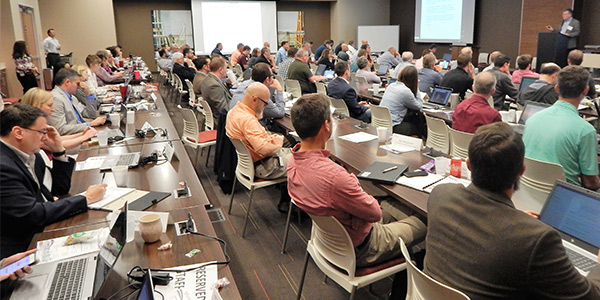By Tom Kleckner
LITTLE ROCK, Ark. — The predominance of renewable energy and battery storage in the nation’s RTO interconnection queues is certainly no secret.
SPP’s queue is dominated by 51.8 GW of wind projects in all stages of study and development. That’s on top of 21.6 GW of installed wind capacity and another 7.7 GW of unbuilt projects with signed interconnection agreements. Layered on top of that is 25 GW of solar projects in the queue — 215 MW is already installed — along with 4.5 GW of battery storage.
Casey Cathey, SPP manager of reliability planning and seams, listed those numbers as he moderated a panel Thursday devoted to planning for an evolving grid.
“What’s our next challenge?” Cathey asked ITC Holdings’ director of regional planning, Alan Myers.
“Isn’t that enough?” Myers responded, drawing laughter from those gathered last week for SPP’s Engineering Planning Summit.
Turning serious, Myers offered a response: “It’s matching that variable to the variability of the load.”
“It used to be generation was the variable. Now, we’re seeing load becoming a huge variable,” said fellow panelist Holly Carias, NextEra Energy Resources’ director of origination. “It will take different technologies to maximize what we already have. Not only with transmission, but on the load side. We have to focus on providing service to the end customer and give them a better customer experience.”
Daniel Brooks, who manages the Electric Power Research Institute’s grid operations and planning research group, threw a wrench into the discussion when he reminded the panel and audience, “EVs are coming.”
Brooks said 10 to 20 years ago, automakers were first attempting to turn a car’s wheels with batteries.
“Listen to those [original equipment manufacturers] today. They’re completely committed to moving to electric vehicle fleets,” he said. “Some heavy-duty vehicle fleets are talking about multi-megawatt charging stations. That’s a challenge, but an opportunity as well.”
As Brooks is fond of saying, “It’s tough to make predictions, especially about the future.”
So far, SPP has been pretty successful with its forecasts. It says its planning efforts have resulted in $10 billion of construction projects over the last 14 years, allowing the RTO to focus on smaller upgrades and reliability projects.
The RTO’s Board of Directors in April approved a $1.8 billion Transmission Expansion Plan that will build projects in 13 states over the next five years. Members last year completed 98 transmission system upgrades in seven states at an estimated cost of $779 million.
A 2016 SPP study indicated $3.4 billion of transmission upgrades during 2012-2014 resulted in more than $240 million in fuel-cost savings for SPP members during the first year of the Integrated Marketplace. The RTO has said it expects the benefits to exceed a net present value of $16.6 billion into the 2050s, with a benefit-to-cost ratio of 3.5. (See SPP Begins Promotional Campaign to Tout Transmission Value.)
‘Big Boys’
“Transmission planning provides a lot of value, particularly when it results in construction,” SPP Engineering Vice President Lanny Nickell said in opening the summit Wednesday. “We have a lot of metrics that have determined we do provide a lot of value through the expansion of transmission.”
Stakeholders reviewed the transmission projects that could make up the 2019 Integrated Transmission Planning assessment, which will go before the board in October for approval.
The 2019 portfolio’s cost could be as high as $407 million, though staff estimate the projects could provide as much as $2 billion in benefits. Several of the projects target the southern corner of SPP’s footprint in Kansas and Missouri. There, congestion on MISO’s side of the seam has resulted in more than $60 million in market-to-market payments to SPP since March 2015. Constructing new 345-kV lines in the area could cost as much as $158 million, according to one proposed project.
Cathey noted SPP can no longer look at other RTOs — and Denmark and Germany, both leaders in renewable integration — for guidance on the ratemaking that will eventually help pay for the lines.
“SPP is kind of at the forefront of some of these challenges. We’re kind of the big boys now,” he said.
“A big gap I see is that relationship between planning and regulatory. We’ve always been on the tail end. We find out what the regulatory decision is, then we scramble to make our plan fit that,” SPP Planning Director Antoine Lucas responded. “I don’t think we can expect that we’ll drive the regulatory process, but there has to be some form of collaboration on the front end to develop solutions that benefit both sides. It will be a big value-add if we can figure out ways to work in different partnerships with different organizations to tackle these problems.”
As the summit wound to a close, Jay Caspary, SPP’s director of research and development and special studies, reminded stakeholders that the RTO and its members will also have to deal with the footprint’s aging infrastructure, some of which is more than 60 years old.
“We’ve got to manage these assets in the field,” he said, referring to himself as an “aging asset too.”
“There are a lot of uncertainties, but one thing that isn’t is that time marches on. These things are getting older by the day. I want us to get ahead of that.”
“There’s a lot to consider. It’s not like it was 10 years ago,” Cathey said. “These will be interesting times moving forward. We’ll see if we’re accurate with our transmission planning as we were with all the transmission we built 20 years ago.”






